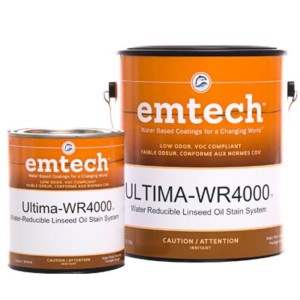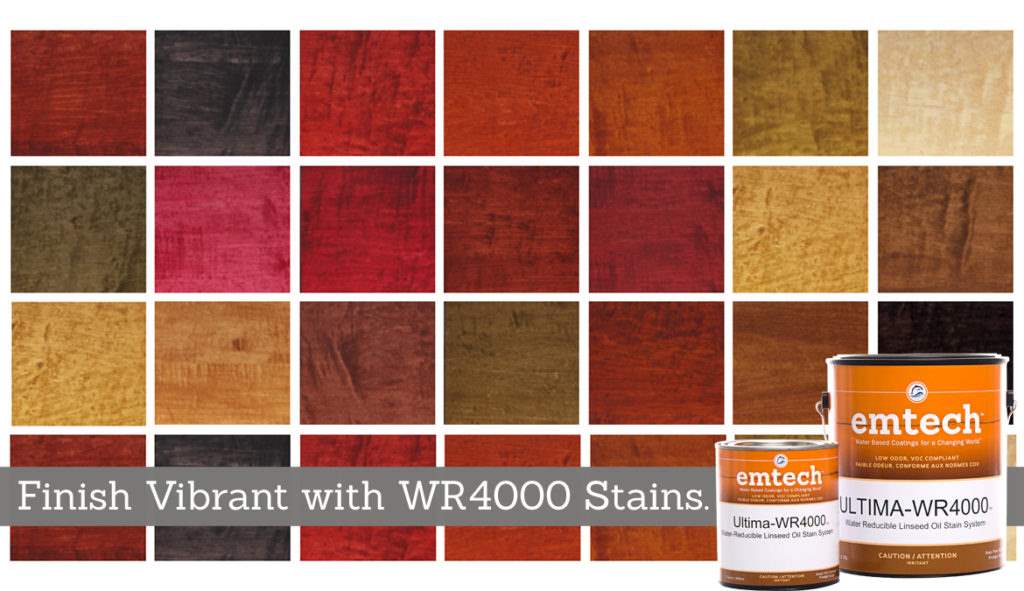
Wood Staining— The application of a transparent color onto a wood substrate to enhance and accentuate the grain pattern of the wood fiber is the most common step in the art and science of wood finishing. The selection and application of the wood stain will make or break your finishing schedule. It has to be done right—or the project can be ruined. Reassuring words? No, but it has to be known before going into the project what it is you are working with and how you need to approach the process. Wood stains can be both friend and foe—and this video I’ve put together shows how to apply waterborne wood stain for a great finish.
So what exactly are wood stains and how do they differ? Choosing the right type of stain is important as you need to understand how they can be applied and manipulated to work with you in your process. The two common types of wood stains are solvent-based, also referred to as oil-based, and water-based, also referred to as waterborne wood stain and hybrid stains. The medium in which the colorant is carried in, i.e. the binder, will determine how the stain in question can be cleaned, how long it will stay open in terms of workability, and what type of finishes it is compatible with.
Solvent-based stains tend to be blends organic pigment and dye colorants dispersed into mineral spirits and other aromatic solvents mixed with low percentages of an oil such as turpentine or linseed—which are the resin binders used to create the film formation. While being easy to apply and work with due to their long dry-time window, solvent-based stains, on average, clean-up with mineral spirits and are flammable in both their liquid stage and combustible when saturated in rags, brushes and spray booth filters.
Water-based stains, also known as waterborne and hybrid stains, are built with colorants and resins that use water as the primary solvent to maintain open-time and color movement. The average water-based stain uses acrylic as a binder—which as we know, can create a problem with lap marks and excessive film build when more of the same stain is applied over itself. Water-based stains are low-VOC and are rated as non-flammable. While being very safe to use in a professional or DIY shop they can be temperamental to work with on large projects.
Unlike conventional water-based stain that is built upon acrylic resins, EMTECH WR4000 Stain Series uses hybridized linseed oil dispersed in a very low percentage of water and water-soluble solvents to function as the color vehicle. Due to this hybridization EMTECH WR4000 Stains penetrate deeply into the grain pattern, allowing for a color reaction and definition that is identical to historically correct linseed based stains. This linseed hybrid allows for the stain to remain open longer as well as controlling the lap effect. EMTECH WR4000 Stains will generate all of the color richness of solvent-based stains, but with the safety and convenience of a water-based system.
Understanding the make-up and function of the wood stain you are choosing to work with on your next professional or DIY project is critical to the overall success of the piece being finished. Both solvent and water-based stains have important places in your decision making process. I strongly recommend that you make sample boards, i.e. storyboards, using the full range of the finishing process to determine what type of stain you will work with and how it will tie-into the sealer and top coat applications that follow.
Give us a call at Target Coatings. We’ll explain the EMTECH WR4000 Stain Series to you in greater detail and how it will work on your next project. As always, thank you for your time and consideration.


Do you have any distributors in Colorado? I checked PPG Paints in Las Vegas, but your products are not shown on their site.
Jan — Thank you for your inquiry. We are working with PPG on this option. Please stand-by.
JW
I am making a cherry bookcase and planned on shooting the WB lacquer but think it may be too light and would like to have a slightly richer darker cherry look.
Should I use a stain first to use a CV topcoat to get a richer look?
Thanks if anyone can help.
Joe — Look at our USH3000 Ultra-Seal Shellac as a color toner in cherry. Also, we make a stain in the WR4000 Stain Series called Cherry Toner (WR417xx) which will warm up the cherry to look slightly sun-burned/aged prior to applying the EM8000cv (or Emtech finish of your choice).
–JW–